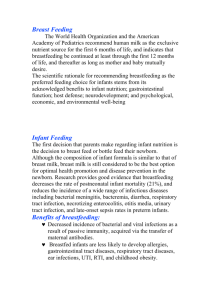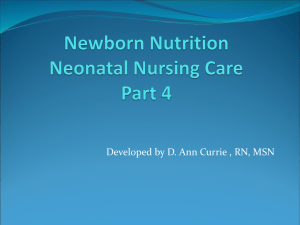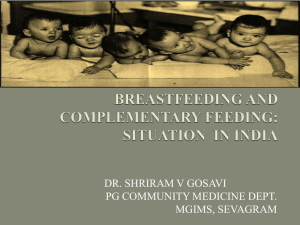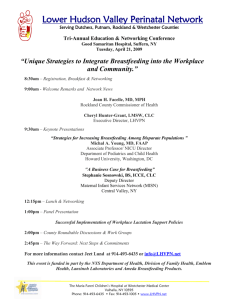1.3 Recommended infant and young child feeding practices
advertisement
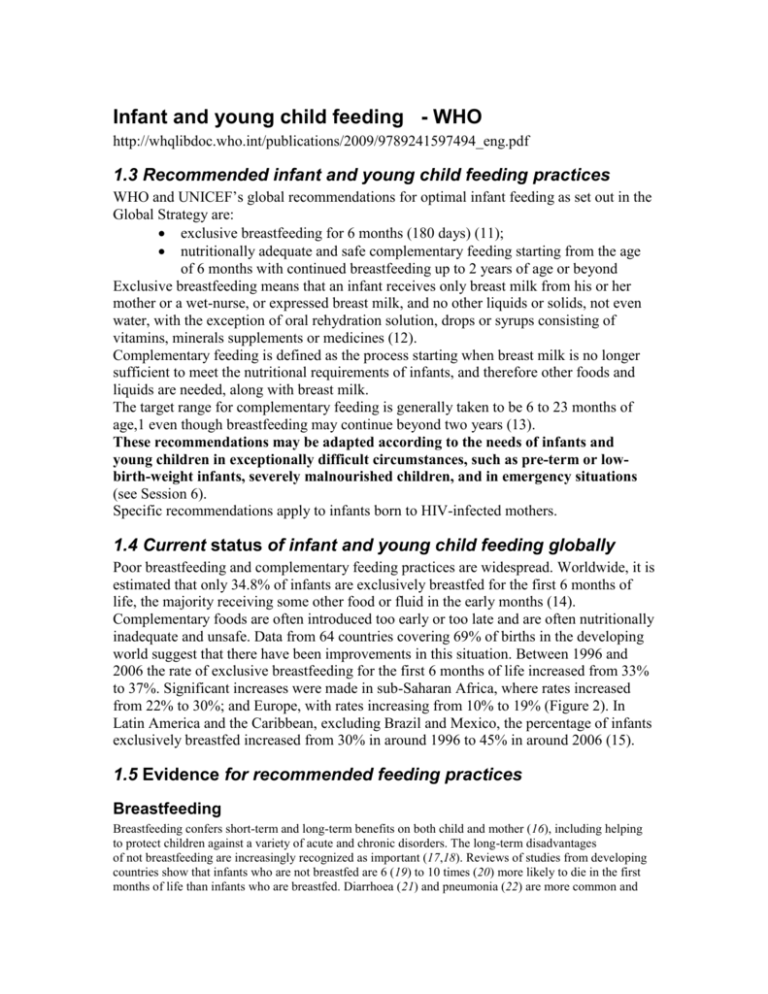
Infant and young child feeding - WHO http://whqlibdoc.who.int/publications/2009/9789241597494_eng.pdf 1.3 Recommended infant and young child feeding practices WHO and UNICEF’s global recommendations for optimal infant feeding as set out in the Global Strategy are: exclusive breastfeeding for 6 months (180 days) (11); nutritionally adequate and safe complementary feeding starting from the age of 6 months with continued breastfeeding up to 2 years of age or beyond Exclusive breastfeeding means that an infant receives only breast milk from his or her mother or a wet-nurse, or expressed breast milk, and no other liquids or solids, not even water, with the exception of oral rehydration solution, drops or syrups consisting of vitamins, minerals supplements or medicines (12). Complementary feeding is defined as the process starting when breast milk is no longer sufficient to meet the nutritional requirements of infants, and therefore other foods and liquids are needed, along with breast milk. The target range for complementary feeding is generally taken to be 6 to 23 months of age,1 even though breastfeeding may continue beyond two years (13). These recommendations may be adapted according to the needs of infants and young children in exceptionally difficult circumstances, such as pre-term or lowbirth-weight infants, severely malnourished children, and in emergency situations (see Session 6). Specific recommendations apply to infants born to HIV-infected mothers. 1.4 Current status of infant and young child feeding globally Poor breastfeeding and complementary feeding practices are widespread. Worldwide, it is estimated that only 34.8% of infants are exclusively breastfed for the first 6 months of life, the majority receiving some other food or fluid in the early months (14). Complementary foods are often introduced too early or too late and are often nutritionally inadequate and unsafe. Data from 64 countries covering 69% of births in the developing world suggest that there have been improvements in this situation. Between 1996 and 2006 the rate of exclusive breastfeeding for the first 6 months of life increased from 33% to 37%. Significant increases were made in sub-Saharan Africa, where rates increased from 22% to 30%; and Europe, with rates increasing from 10% to 19% (Figure 2). In Latin America and the Caribbean, excluding Brazil and Mexico, the percentage of infants exclusively breastfed increased from 30% in around 1996 to 45% in around 2006 (15). 1.5 Evidence for recommended feeding practices Breastfeeding Breastfeeding confers short-term and long-term benefits on both child and mother (16), including helping to protect children against a variety of acute and chronic disorders. The long-term disadvantages of not breastfeeding are increasingly recognized as important (17,18). Reviews of studies from developing countries show that infants who are not breastfed are 6 (19) to 10 times (20) more likely to die in the first months of life than infants who are breastfed. Diarrhoea (21) and pneumonia (22) are more common and more severe in children who are artificially fed, and are responsible for many of these deaths. Diarrhoeal illness is also more common in artificially-fed infants even in situations with adequate hygiene, as in Belarus (23) and Scotland (24). Other acute infections, including otitis media (25), Haemophilus influenzae meningitis (26), and urinary tract infection (27), are less common and less severe in breastfed infants. Artificially-fed children have an increased risk of longterm diseases with an immunological basis, including asthma and other atopic conditions (28,29), type 1 diabetes (30), celiac disease (31), ulcerative colitis and Crohn disease (32). Artificial feeding is also associated with a greater risk of childhood leukaemia (33). Several studies suggest that obesity in later childhood and adolescence is less common among breastfed children, and that there is a dose response effect, with a longer duration of breastfeeding associated with a lower risk (34,35). The effect may be less clear in populations where some children are undernourished (36). A growing body of evidence links artificial feeding with risks to cardiovascular health, including increased blood pressure (37), altered blood cholesterol levels (38) and atherosclerosis in later adulthood (39). Regarding intelligence, a meta-analysis of 20 studies (40) showed scores of cognitive function on average 3.2 points higher among children who were breastfed compared with those who were formula fed. The difference was greater (by 5.18 points) among those children who were born with low birth weight. Increased duration of breastfeeding has been associated with greater intelligence in late childhood (41) and adulthood (42), which may affect the individual’s ability to contribute to society. For the mother, breastfeeding also has both short- and long-term benefits. The risk of postpartum haemorrhage may be reduced by breastfeeding immediately after delivery (43), and there is increasing evidence that the risk of breast (44) and ovarian (45) cancer is less among women who breastfed. Exclusive breastfeeding for 6 months The advantages of exclusive breastfeeding compared to partial breastfeeding were recognised in 1984, when a review of available studies found that the risk of death from diarrhoea of partially breastfed infants 0–6 months of age was 8.6 times the risk for exclusively breastfed children. For those who received no breast milk the risk was 25 times that of those who were exclusively breastfed (46). A study in Brazil in 1987 found that compared with exclusive breastfeeding, partial breastfeeding was associated with 4.2 times the risk of death, while no breastfeeding had 14.2 times the risk (47). More recently, a study in Dhaka, Bangladesh found that deaths from diarrhoea and pneumonia could be reduced by one third if infantswere exclusively instead of partially breastfed for the first 4 months of life (48). Exclusive breastfeeding for 6 months has been found to reduce the risk of diarrhoea (49) and respiratory illness (50) compared with exclusive breastfeeding for 3 and 4 months respectively. If the breastfeeding technique is satisfactory, exclusive breastfeeding for the first 6 months of life meets the energy and nutrient needs of the vast majority of infants (51). No other foods or fluids are necessary. Several studies have shown that healthy infants do not need additional water during the first 6 months if they are exclusively breastfed, even in a hot climate. Breast milk itself is 88% water, and is enough to satisfy a baby’s thirst (52). Extra fluids displace breast milk, and do not increase overall intake (53). However, water and teas are commonly given to infants, often starting in the first week of life. This practice has been associated with a two-fold increased risk of diarrhoea (54). For the mother, exclusive breastfeeding can delay the return of fertility (55), and accelerate recovery of pre-pregnancy weight (56). Mothers who breastfeed exclusively and frequently have less than a 2% risk of becoming pregnant in the first 6 months postpartum, provided that they still have amenorrhoea (see Session 8.4.1). Complementary feeding from 6 months From the age of 6 months, an infant’s need for energy and nutrients starts to exceed what is provided by breast milk, and complementary feeding becomes necessary to fill the energy and nutrient gap (57). If complementary foods are not introduced at this age or if they are given inappropriately, an infant’s growth may falter. In many countries, the period of complementary feeding from 6–23 months is the time of peak incidence of growth faltering, micronutrient deficiencies and infectious illnesses (58). Even after complementary foods have been introduced, breastfeeding remains a critical source of nutrients for the young infant and child. It provides about one half of an infant’s energy needs up to the age of one year, and up to one third during the second year of life. Breast milk continues to supply higher quality nutrients than complementary foods, and also protective factors. It is therefore recommended that breastfeeding on demand continues with adequate complementary feeding up to 2 years or beyond (13). Complementary foods need to be nutritionallyadequate, safe, and appropriately fed in order to meetthe young child’s energy and nutrient needs. However, complementary feeding is often fraught with problems, with foods being too dilute, not fed often enough or in too small amounts, or replacing breast milk while being of an inferior quality. Both food and feeding practices influence the quality of complementary feeding, and mothers and families need support to practise good complementary feeding (13). References 1. World Health Organization. The global burden of disease: 2004 update. Geneva, World Health Organization, 2008. 2. Black RE et al. Maternal and child undernutrition: global and regional exposures and health consequences. Lancet, 2008, 371:243–60. 3. Martorell R, Kettel Khan L, Schroeder DG. Reversibility of stunting: epidemiological findings in children from developing countries. European Journal of Clinical Nutrition, 1994, 58 (Suppl.1):S45–S57. 4. Pollitt E et al. Nutrition in early life and the fulfilment of intellectual potential. The Journal of Nutrition, 1995, 125:1111S–1118S. 5. Grantham-McGregor SM, Cumper G. Jamaican studies in nutrition and child development, and their implications for national development. The Proceedings of the Nutrition Society, 1992, 51: 71–79. 6. Haas JD et al. Early nutrition and later physical work capacity. Nutrition reviews, 1996, 54(2,Pt2): S41–48. 7. Martin RM et al. Parents’ growth in childhood and the birth weight of their offspring. Epidemiology, 2004, 15:308–316. 8. World Bank. Repositioning nutrition as central to development: a strategy for large scale action. Washington DC, The World Bank, 2006. 9. Jones G et al. How many child deaths can we prevent this year? Lancet, 2003, 362:65–71. 10. WHO/UNICEF. Global strategy for infant and young child feeding. Geneva, World Health Organization, 2003. 11. Kramer MS, Kakuma R. The optimal duration of exclusive breastfeeding: a systematic review. Geneva, World Health Organization, 2001(WHO/ NHD/01.08; WHO/FCH/01.23). 12. WHO/UNICEF/USAID. Indicators for assessing infant and young child feeding practices. Geneva, World Health Organization, 2008. 13. PAHO/WHO. Guiding principles for complementary feeding of the breastfed child. Washington DC, Pan American Health Organization/World Health Organization, 2002. 14. WHO Global Data Bank on Infant and Young Child Feeding, 2009. 15. UNICEF. Progress for children: a world fit for children. Statistical Review Number 6. New York, UNICEF, 2007. 16. Leon-Cava N et al. Quantifying the benefits of breastfeeding: a summary of the evidence. Washington DC, Pan American Health Organization, 2002. 17. Fewtrell MS. The long-term benefits of having been breastfed. Current Paediatrics, 2004, 14:97–103. 18. WHO. Evidence on the long-term effects of breastfeeding: systematic reviews and meta-analyses. Geneva, World Health Organization, 2007. 19. WHO Collaborative Study Team on the Role of Breastfeeding on the Prevention of Infant Mortality. Effect of breastfeeding on infant and childhood mortality due to infectious diseases in less developed countries: a pooled analysis. Lancet, 2000, 355:451–455. 20. Bahl R et al. Infant feeding patterns and risks of death and hospitalization in the first half of infancy: multicentre cohort study. Bulletin of the World Health Organization, 2005, 83:418–426. 21. De Zoysa I, Rea M, Martines J. Why promote breast feeding in diarrhoeal disease control programmes? Health Policy and Planning, 1991, 6:371–379. 22. Bachrach VR, Schwarz E, Bachrach LR. Breastfeeding and the risk of hospitalization for respiratory diseases in infancy: a meta-analysis. Archives of Pediatrics and Adolescent Medicine, 2003, 157:237–243. 23. Kramer MS et al. Promotion of Breastfeeding Intervention Trial (PROBIT): a randomized trial in the Republic of Belarus. Journal of the American Medical Association, 2001, 285:413–420. 24. Howie PW et al. Protective effect of breastfeeding against infection. British Medical Journal, 1990, 300:11–16.
